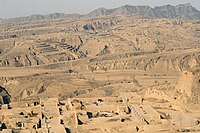
Photo from wikipedia
Here we present, to date, the highest‐resolved (~5 years) and most precisely dated Holocene monsoon climate reconstruction for the western Chinese Loess Plateau based on five replicated stalagmite δ18O records… Click to show full abstract
Here we present, to date, the highest‐resolved (~5 years) and most precisely dated Holocene monsoon climate reconstruction for the western Chinese Loess Plateau based on five replicated stalagmite δ18O records from Wuya Cave, eastern Gansu, China. Our record suggests the wettest period occurred between 10,500 and 6,600 a BP in this region. After this period, the amplitude of Asian summer monsoon decadal‐scale variability progressively increased likely in response to increasing ENSO frequency since the middle Holocene. Our study reveals similar asymmetric centennial‐scale double‐plunging structures of the 8.2, 5.5, and 2.8 ka events in the western Chinese Loess Plateau, suggesting a possible role of solar activity whose impact was amplified around 8.2 ka BP by the meltwater flood. In contrast, the 4.2 ka event exhibit gradually declining monsoon rainfall with centennial‐ to decadal‐scale fluctuations.
Journal Title: Geophysical Research Letters
Year Published: 2020
Link to full text (if available)
Share on Social Media: Sign Up to like & get
recommendations!